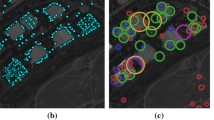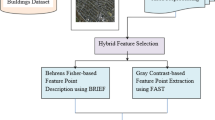Abstract
An approach to building area extraction from high-resolution remote sensing imagery is proposed based on the local gradient orientation density function (LGODF) and the bimodal density function (BDF). Firstly, the LGODF is calculated by moving the window of 35 × 35 based on the gradient magnitude and the gradient direction of each pixel in the image. Then, the BDF is obtained by multiplying the movable bimodal Gaussian mixture function and LGODF in each window. Finally, peaks with difference of 90° are searched for in the BDF, and the central point of the corresponding windows are determined as building pixels. For the validity of the proposed method, seven representative sub-images from PLEIADES images covering Shenzhen China are selected. Experimental results reveal that the precision achieve 94.08% and the recall up to 96.70%.








Similar content being viewed by others
References
Ahmadi S, Zoej MJV, Ebadi H et al (2010) Automatic urban building boundary extraction from high resolution aerial images using an innovative model of active contours. International Journal of Applied Earth Observations & Geoinformation 12(3):150–157
Benedek C, Descombes X, Zerubia J (2011) Building development monitoring in multitemporal remotely sensed image pairs with stochastic birth-death dynamics. IEEE Transactions on Pattern Analysis & Machine Intelligence 34(1):33–50
Benediktsson JA, Pesaresi M, Amason K (2003) Classification and feature extraction for remote sensing images from urban areas based on morphological transformations. IEEE Trans Geosci Remote Sens 41(9):1940–1949
Gamba P, Dell’ Acqua F, Lisini G et al (2007) Improved VHR urban area mapping exploiting object boundaries. IEEE Transactions on Geoscience & Remote Sensing 45(8):2676–2682
Jiménez LI, Plaza J, Plaza A (2017) Efficient implementation of morphological index for building/shadow extraction from remotely sensed images. J Supercomput 73(1):482–494
Kaur I, Nimisha GR (2016) Adaptive SLIC along with texture feature based segmentation of urban area. Advanced Research in Electrical and Electronic Engineering 3(4):278–282
Mannokovacs A, Sziranyi T (2013) Multidirectional building detection in aerial images without shape templates. ISPRS-international archives of the photogrammetry. Remote Sensing and Spatial Information Sciences XL-1/W1(1):227–232
Montoyazegarra JA, Wegner JD, Ladický L et al (2015) Semantic segmentation of aerial images in urban areas with class-specific higher-order cliques. ISPRS Annals of Photogrammetry, Remote Sensing and Spatial Information Sciences II-3/W4:127–133
Ok AO (2013) Automated detection of buildings from single VHR multispectral images using shadow information and graph cuts. ISPRS J Photogramm Remote Sens 86:21–40
Pesaresi M (2001) Benediktsson J a. A new approach for the morphological segmentation of high-resolution satellite imagery. IEEE Trans Geosci Remote Sens 39(2):309–320
Pesaresi M, Gerhardinger A, Kayitakire F (2008) A robust built-up area presence index by anisotropic rotation-invariant textural measure. IEEE Journal of Selected Topics in Applied Earth Observations & Remote Sensing 1(3):180–192
Senaras C, Ozay M, Vural FTY (2013) Building detection with decision fusion. IEEE Journal of Selected Topics in Applied Earth Observations and Remote Sensing 6(3):1295–1304
Shackelford AK (2003) Davis C H. A combined fuzzy pixel-based and object-based approach for classification of high-resolution multispectral data over urban areas. IEEE Trans Geosci Remote Sens 41(10):2354–2363
Sirmacek B, Unsalan C (2009) Urban-area and building detection using sift keypoints and graph theory. IEEE Transactions on Geoscience & Remote Sensing 47(4):1156–1167
Su W, Li J, Chen Y et al (2008) Textural and local spatial statistics for the object-oriented classification of urban areas using high resolution imagery. Int J Remote Sens 29(11):3105–3117
Sumer E, Turker M (2013) An adaptive fuzzy-genetic algorithm approach for building detection using high-resolution satellite images. Comput Environ Urban Syst 39:48–62
Unsalan C, Boyer KL (2004) Classifying land development in high-resolution panchromatic satellite images using straight-line statistics. IEEE Trans Geosci Remote Sens 42(4):907–919
Ünsalan C, Boyer KL (2005) A system to detect houses and residential street networks in multispectral satellite images. Comput Vis Image Underst 98(3):423–461
Xi Y, Luo Q (2018) A morphology-based method for building change detection using multi-temporal airborne LiDAR data. Remote Sensing Letters 9(2):131–139
Zhong P (2007) Wang R. A multiple conditional random fields ensemble model for urban area detection in remote sensing optical images. IEEE transactions on geoscience. Remote Sens 45(12):3978–3988
Acknowledgments
This work was supported by National Natural Science Foundation of China (Grant No. 41701491), Natural Science Foundation of Fujian Province, China (Grant No. 2017 J01464), Special Funds of the Central Government Guiding Local Science and Technology Development (2017 L3009) and Program for Changjiang Scholars and Innovative Research Team in University (Grant No. IRT_15R10).
Author information
Authors and Affiliations
Corresponding authors
Additional information
Communicated by: H. Babaie
Rights and permissions
About this article
Cite this article
Shi, W., Mao, Z. & Liu, J. Building area extraction from the high spatial resolution remote sensing imagery. Earth Sci Inform 12, 19–29 (2019). https://doi.org/10.1007/s12145-018-0355-5
Received:
Accepted:
Published:
Issue Date:
DOI: https://doi.org/10.1007/s12145-018-0355-5




